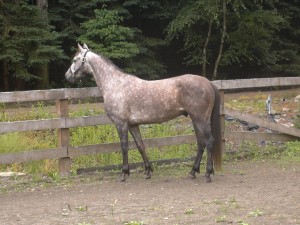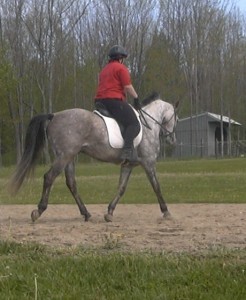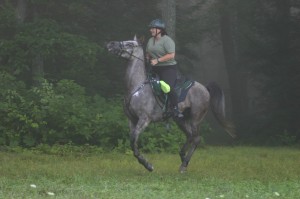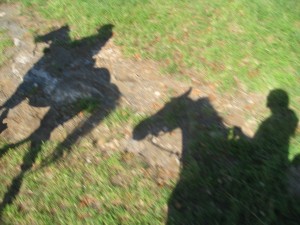Non-endurance riding friends, especially my dressage friends, marvel at the fact that I was able to get two horses fit for a hundred mile ride this season.
Now, I will concede that in many ways, I am blessed with the perfect career, the perfect farm, and a workaholic husband who makes many things possible, and also competes. However, I also contend that it is far easier to KEEP a horse fit for endurance riding than one might imagine.

(A photo of what I do in “real life” — providing safety training to my clients’ employees. In this case, Hazmat Team training for emergency responders.)
The hard part is the training, not the conditioning (and yes, there is a difference) and in bringing a young or inexperienced horse through their first year or so of becoming an endurance horse. That is where the real investment lies.
I was fortunate to have a friend purchase a barely started green 6 year old mare the same year as I purchased Ace, then a recently backed 5 year old with no power steering, little in the way of power brakes and a somewhat perplexing and curious response to a request to any rein contact with a snaffle bit; he simply twisted his head and neck in the opposite direction and pulled.
5 y.o. neon greenbean Ace comes to Iris Hill Farm.

That meant quality time in the area of training. Training to give to pressure, to travel forward from a lightly asked leg aid without rushing, to halt from a settling of the seat and a drop of the heels rather than less than subtle pressure on his mouth. Training to learn to bend his body on a curved line, and to move his hindquarters away from pressure well behind the girth, as well as balance his own body when he traveled rather than to simply fall onto his forehand.
Yep, we call that basic dressage, and to me, it is essential to having a pleasant and safe ride down the trail.
[This is not to say that Ace is a dressage horse. That was Ned’s first career, but Ace is a different character altogether, and with some kind of physical goings-on that we’ve never quite been able to resolve involving his mouth, jaw and nuchal ligament, he’ll never get a good score on even a training level dressage test. He has two neck postures — upright and curled, and we’ve finally had to sadly conclude that like a person who cannot walk and chew gum, Ace just doesn’t have what it takes to stretch his neck and open his throatlatch on a steady contact. It is one of the things that makes Ace uniquely Ace, and I am convinced he came in to my life to prove to me that not all horses were meant to do dressage competitively. So I simply ride him in a running martingale, and compromise the posture of the part of the horse in front of me, and focus on a body and limbs that are traveling straight and balanced. The ultimate lesson in riding back to front and simply making concessions on the front.
Ace is not a dressage horse, and wouldn’t be cast as one on TV
But I digress … ]

Other training becomes critical in these young horses. Trailer loading and trailer hauling, and how to camp in a paddock or on a hi-tie, leading down the trail without searching out phantom mountain lions in every blown down leaf or tree stump, and following without encroaching upon the space of the horse in front. Standing still to be mounted, regardless of the strange spot selected by a vertically-challenged rider.
Learning to stand tied quietly for long periods of time, regardless of whether horses come or go. Ace was a slow learner on this one, and spent hours tied to a sturdy tree outside of our riding ring while I rode another horse, or did chores, or just sat on the porch watching him work out his dramatic energy and learning that simply standing still was the best of his options.
This. This training is the hard part of bringing along a distance horse. Lots of peppermints and pats and praise and lots of starting over again when the progress goes along at the rate of one step forward, two steps back.
As Benjamin Franklin said, “Make Haste Slowly.”
The conditioning, relative to the training, is easy, but the same rules apply.
Long, slow miles where the horse learns to balance and keep a steady pace, navigating ups and down and challenging footing. I remember days and hours of riding along with my friend Carla on her green horse, simply going along at a steady pace, slowing to a walk when either horse became unbalanced or frazzled or spooky or rushed.
Long, slow miles where the horse learns to trust that the rider is his partner and is there to guide the way and that certain requests are not optional.
Long, slow miles where the horse is eventually trusted, to some degree, to decide how to pick along a trail, how to trip without falling, how to navigate the fear of a new obstacle without refusing, how to take care of himself and stop for a snack or a long sip of water or accept being sponged in a creek to cool down his body.
Pennies in a jar, I once told a friend, pennies in a jar. Adding pennies of trust and easy requests, layered with more difficult questions, and occasionally losing ground and asking too much and withdrawing a few pennies, only to add more. Never ever allowing the jar to become empty, asking more than you’ve invested.
Long, slow miles where tendons and ligaments harden and you learn if you have a downhill horse, or if he’ll be ouchy on rocks, and whether he prefers cool, clear running water or a mucky puddle. If his saddle fits and if the farrier made his toes short enough for him to travel at his best, and if you’d best hold on for dear life when he sees cows or bicycles or babies in a stroller. This time does not make the horse perfect — no, no, no — I have three competing horses in my barn full of foibles to prove that; it simply ensures they are fairly predictable and rideable.
All the hard work is done, or should be done –as I’ve seen plenty of evidence of riders who seem to skip so many of these steps, forgetting to invest pennies before they withdraw them– before you ever reach your first competition.
So many riders seem to focus on heart rates and cardiac recovery, but these are the first to develop (and also the first to go when a horse has extended time off). Or worry about the horse being fast rather than whether the horse has what it takes to reliably get around the course.
It is the time, months and even years, that builds the bone, the connective tissues, the metabolic ability to go for a long distance and then repeat the effort, the muscle, the topline and the most important organ, and the brain. Until the remarkable day comes that a rider can sit back and smile a contented smile knowing that their horse has “a base.”
It took Carla and I easily a year with our two young horses before we could say they had a base. All that training, all that conditioning, a few CTRs or LDs and a slow 50 or two under their belt. It was then that we knew we had the hard part done.
One of my all-time favorite photos of me and Ace at one of his first LD rides. I’m happy as a lark because he was letting me control the MPH. What do you mean he doesn’t look like a dressage horse?

Photo credit Kate Rogers.
Ah, a horse with a base. Hundreds and hundreds of carefully planned miles, carefully planned rest (for more on that, see my Endurance News article about Rest under ”Articles”), lots and lots of carrots and trailering sessions and camping with one eye constantly on the horse to make sure he was eating, drinking, peeing and pooping, not pacing his paddock or escaping into the night or caught like a goat in a piggin’ rope in his HiTie.
With three horses with a solid base, life becomes much, much easier. One plans their rides around competitions, enjoys what seems like a very little bit of conditioning to bring the horse back into competition fitness, using competitions as the way to gain fitness needed for a tougher challenge, a longer distance. And if you’re like me, one plans tons of fun and non-horsey activities in the week or weeks that follow a ride, knowing the horse will be enjoying a mental and physical rest, easily brought back for the next ride. Or enjoying the sheer laziness that is a western New York winter, with the horses’ shoes pulled, their coats long and woolly, assuring yourself that this is not sloth, that this is a pre-planned and critical rest period for the horses. So you bake Christmas cookies, and hibernate and take care of the myriad of indoor projects you neglected while throwing yourself into the joy and obsession that is riding season.

Ace enjoys a romp in the riding ring during winter vacation
Everyone needs a little down time to re-charge their batteries.
With my own business, I’m grateful to be able to plan my own schedule to some degree. My clients do not know that when I say I’m already booked for a particular date, that it may mean I am booked with the farrier, or booked to be driving to some distant state to compete. But work I must, and if it means I am gone for a week, well then, I plan a long conditioning ride for the days right before I hit the road, reassuring myself that my horse is spending my away time resting and recovering and knitting together the tissues we challenged on the conditioning ride.
And thus, getting two horses ready for a hundred, not such a big deal. Fun little conditioning rides, slow at first, then increasing the speed or the distance or the elevation changes (but not more than one on the same day). Planning ahead about when we’ll schedule the toughest conditioning, how we’ll taper, when to have the farrier reset shoes. Asking enough, but never too much. Pennies in a jar.

The culmination of pennies in a car. Photo credit Rachel Lodder. VT 100.
Life is good, indeed, having three horses with a base in the barn. Two hundred-mile horses and one more who I am just jonesing to enter in a 100, with my husband’s permission. Maybe at the end of the season.
But there is a little part of me itching again. Itching to find another young horse with very little in terms of training but tons of potential. Another horse to teach me how to do this thing all over again, a little differently, a little smarter, a new jigsaw puzzle to solve.
Careful, Rich — if you’re smart, you’ll never build that fifth stall!
